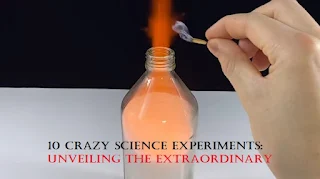Science has an uncanny ability to push the boundaries of human knowledge and occasionally veer into the realm of the extraordinary. In this exploration of Crazy Science Experiments, we'll venture into the fascinating world of scientific innovation and discovery. From mind-bending physics to mind-altering chemistry, these experiments reveal the audacious spirit of scientific inquiry.
1. The Double-Slit Experiment: Unmasking Quantum Weirdness
The Double-Slit Experiment is a cornerstone of quantum mechanics. It defies common sense by demonstrating that particles, like electrons, behave as both particles and waves simultaneously. The mind-boggling result? Particles can exist in multiple places at once. It's the epitome of crazy science experiments.
2. The Stanford Prison Experiment: Delving into Human Behavior
This infamous social psychology study, known as the Stanford Prison Experiment, explored the dark side of human behavior. Participants were assigned roles as prisoners or guards in a simulated prison. The experiment spiraled out of control, revealing the chilling transformation of ordinary individuals into abusive captors.
3. The LHC: Hunting for the Higgs Boson
The Large Hadron Collider (LHC) is the world's most powerful particle accelerator. In 2012, it made headlines by confirming the existence of the Higgs Boson, a fundamental particle responsible for giving mass to other particles. This colossal machine delves into the mysteries of the universe, making it a prime example of crazy science experiments.
WhatsApp Tricks - Unveiling the Latest WhatsApp Tricks for 2023
4. The Milgram Experiment: Uncovering Obedience to Authority
5. The Casimir Effect: Harnessing Quantum Forces
In the realm of quantum physics, the Casimir Effect is a mind-blowing phenomenon. It occurs when two uncharged plates are placed extremely close together, resulting in a measurable force due to quantum fluctuations in the vacuum. This peculiar experiment challenges our understanding of the empty space between particles.
6. The Monster Study: Scarring Young Minds
In the 1930s, an experiment known as the Monster Study aimed to understand the development of stuttering in children. However, it took a dark turn as young subjects were subjected to intense criticism, leading to psychological scars. The controversial nature of this experiment has sparked ethical debates ever since.
7. The Quantum Eraser Experiment: Retroactive Observations
The Quantum Eraser Experiment delves into the concept of retroactive observations in quantum mechanics. It suggests that the act of observing a particle's behavior can influence its past behavior. This bewildering concept challenges our perception of causality and time itself.
8. The Little Albert Experiment: Conditioning Fear
In the Little Albert Experiment, a baby known as "Little Albert" was conditioned to fear white rats by pairing their presence with loud, frightening noises. This experiment demonstrated the concept of classical conditioning, showing how emotions can be conditioned in humans.
9. The Antigravity Wheel: A Magnetic Mystery
The Antigravity Wheel experiment is an optical illusion that plays tricks on our perception of gravity. When a wheel with a patterned design is spun, it appears to defy gravity by moving in the opposite direction of its actual rotation. This intriguing visual illusion challenges our sense of reality.
10. The Ferrofluid Art: Magnetic Masterpieces
Ferrofluids are mesmerizing liquids that respond to magnetic fields. Artists and scientists have used them to create stunning works of art, with fluidic shapes and movements guided by magnetic forces. These captivating displays showcase the intersection of science and art, making them truly crazy science experiments.



